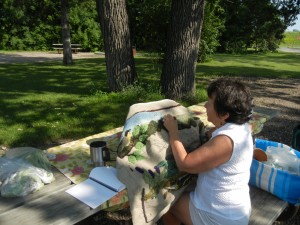We were dismayed to discover (thanks to Rich’s alertness) that two lug nuts were missing from one of the wheels of our camper! We were able to get spare lug nuts at a local auto parts store Saturday evening, but because one of the studs had broken off, we didn’t dare to resume traveling before we could get it repaired. Several phone calls in the morning failed to turn up any repair places open on a Sunday, so we stayed an extra day at Ann & Floyd’s. Until the camper was fixed, we had extra time to explore a couple of nearby bike paths, one along the Black River on Sunday and the other along the Rocky River on Monday. Both were thoroughly enjoyable. We finally headed for Michigan a day and a half later than planned, but feeling very fortunate that we didn’t have a wheel fall off at highway speed!


































